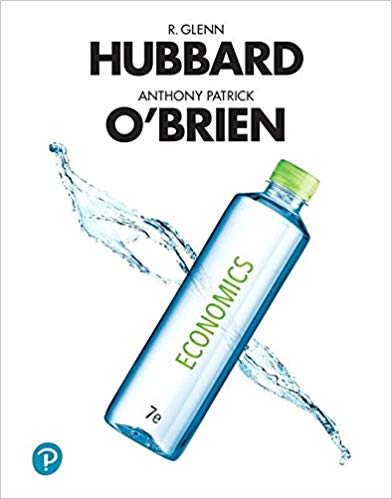
PRINCIPLES OF MICROECONOMICS
 |
| Fall 2020 |
 |
Economics 101 PRINCIPLES OF MICROECONOMICS |
|
|
|
|
|||||||||||||||||||||||||||||||||||||||||||||||||||||||||||||||||||||||||||||||||||||||||||||||||||||||||||||||||
|
III. Miscellaneous A. Comparative Advantage and the Gains from International Trade 1. Definitions
. 2. Comparative advantage and trade a. Absolute advantage
. Ex. - Production is for one hour of labor
.
. b. Comparative advantage
. Ex. - Production is for one hour of labor
.
. c. Gains from trade
. Ex. - Suppose each country as 1,000 hours of labor
. c. Terms of trade
. Ex. - 2,000 TA = 2,500 SP 1 TA = 1.25 SP 0.8 TA = 1 SP .
. 1 TA = 0.5 - 2 SP 1 SP = 0.5 - 2 TA . - If terms of trade are outside these limits, it would be better for the country to produce the product instead of trade for it . d. Why there isn't complete specialization (1) Not all goods and services traded internationally Ex. - Medical services . (2) Production has increasing opportunity cost
. Ex. -
. (3) Tastes for products differ
Ex. - Cars . e. Reasons for comparative advantage (1) Climate and natural resources
Ex. - Saudi Arabia, Costa Rica . (2) Relative abundance of labor and capital
Ex. - China (labor), U.S. (capital) . (3) Technology
- Product technologies - ability to develop new products - Process technologies - ability to improve productive processes Ex. - U.S. (product), Japan (process) . (4) External economies
- More skilled labor available - Can interact with firms in the same industry - Proximity to suppliers Ex. - Tokyo/London/New York (finance), London (theater), Los Angeles (movies)
.
3. Restrictions on trade a. Autarky
. Demand intercept = $4.00 . Consumer surplus (CS) = 1/2 * b * h = 1/2 * 6.0 * ($4.00 - $2.00) = $6.0 billion Producer surplus (PS) = 1/2 * b * h = 1/2 * 6.0 * ($2.00 - $0.00) = $6.0 billion Economic surplus (ES) = CS + PS = $6.0 + $6.0 = $12.0 billion DWL = $15.0 - $12.0 = $3.0 billion
b. Free trade
. A = 1/2 * b * h = 1/2 * 6.0 * ($4.00 - $2.00) = $6.0 billion B = b * h + 1/2 * b * h = 3.0 * ($2.00 - $1.00) + 1/2 * (6.0 - 3.0) * ($2.00 - $1.00) = $4.5 billion C = 1/2 * b * h = 1/2 * (6.0 - 3.0) * ($2.00 - $1.00) = $1.5 billion D = 1/2 * b * h = 1/2 * (9.0 - 6.0) * ($2.00 - $1.00) = $1.5 billion E = 1/2 * b * h = 1/2 * 3.0 * ($1.00 - $0.00) = $1.5 billion . CS = A + B + C + D = $6.0 + $4.5 + $1.5 + $1.5 = $13.5 billion PS = E = $1.5 billion ES = CS + PS = $13.5 + $1.5 = $15.0 billion . c. Tariffs
A = b * h + 1/2 * b * h = 3.0 * ($1.50 - $1.00) + 1/2 * (4.5 - 3.0) * ($1.50 - $1.00) = $1.875 billion T = tariff revenue = b * h = (7.5 - 4.5) * (1.50 - 1.00) = $1.5 billion C = 1/2 * b * h = 1/2 * (4.5 - 3.0) * ($1.50 - $1.00) = $0.375 billion D = 1/2 * b * h = 1/2 * (9.0 - 7.5) * ($1.50 - $1.00) = $0.375 billion . Change in CS = - (A + C + T + D) = - (1.875 + 0.375 + 1.5 + 0.375) = -$4.125 billion Change in PS = A = +$1.875 billion Change in tariff revenue = T = +$1.5 billion DWL = C + D = 0.375 + 0.375 = +$0.75 billion .
- Consumers worse off - Producers better off - More domestic production and employment - Revenue to the government - Economic surplus down . d. Quotas and voluntary export restraints
A = b * h + 1/2 * b * h = 9.6 * ($0.28 - $0.18) + 1/2 * (18.0 - 9.6) * ($0.28 - $0.18) = $1.38 billion B = gain to foreign producers = b * h = (24.7 - 18.0) * ($0.28 - $0.18) = $0.67 billion C = 1/2 * b * h = 1/2 * (18.0 - 9.6) * ($0.28 - $0.18) = $0.42 billion D = 1/2 * b * h = 1/2 * (27.0 - 24.7) * ($0.28 - $0.18) = $0.12 billion . Change in CS = - (A + C + B + D) = - (1.38 + 0.42 + 0.67 + 0.12) = -$2.59 billion Change in PS = A = +$1.38 billion Gain to foreign producers = B = +$0.67 billion DWL = C + D = 0.42 + 0.12 = $0.54 billion .
- Consumers worse off - Producers better off - More domestic production and employment - Benefit to foreign producers accepted by quota - Economic surplus down . e. Other restrictions (1) Health and safety requirements . (2) Restrictions based on national security considerations . 4. Opposition to free trade and globalization
. a. Trade institutions
. b. Anti-globalization (1) Arguments against globalization (a) Trade and investment destroys distinctive cultures of many countries (b) Jobs relocated from high-income countries to low-income countries (c) Low wages paid (d) Lower environmental and safety regulations (e) Child labor sometimes used . (2) Counterarguments (a) More cultural choices (b) Due to comparative advantage (c) Wages high compared to other jobs (d) Easier for developed countries to have high standards (e) Alternatives could be worse . c. Protectionism
(1) Arguments for protectionism (a) Saving jobs
. (b) Protecting high wages
. (c) Protecting infant industries
. (d) Protecting national security
. (2) Counterarguments (a) Due to comparative advantage; jobs in export industries hurt (b) Leads to increases in prices (c) Firms become dependent on protection, don't become efficient (d) Difficult to determine which goods are necessary for national security |
|||||||||||||||||||||||||||||||||||||||||||||||||||||||||||||||||||||||||||||||||||||||||||||||||||||||||||||||||